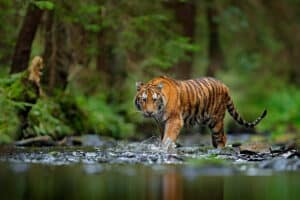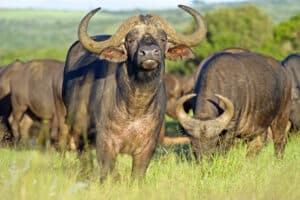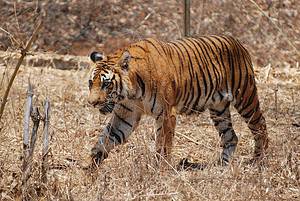If you’ve ever seen a tiger in person, you know how intimidating these animals can be. Sleek muscles cover their large bodies and impressive teeth line their strong jaws. These animals are clearly designed to be prey-crushing, apex predators.
But just how strong are they? A tiger’s bite is one of the strongest of the big cat species. Let’s take a look at the tiger’s bite force, its maximum power, and how it compares to other skilled hunters.
What is Bite Force?
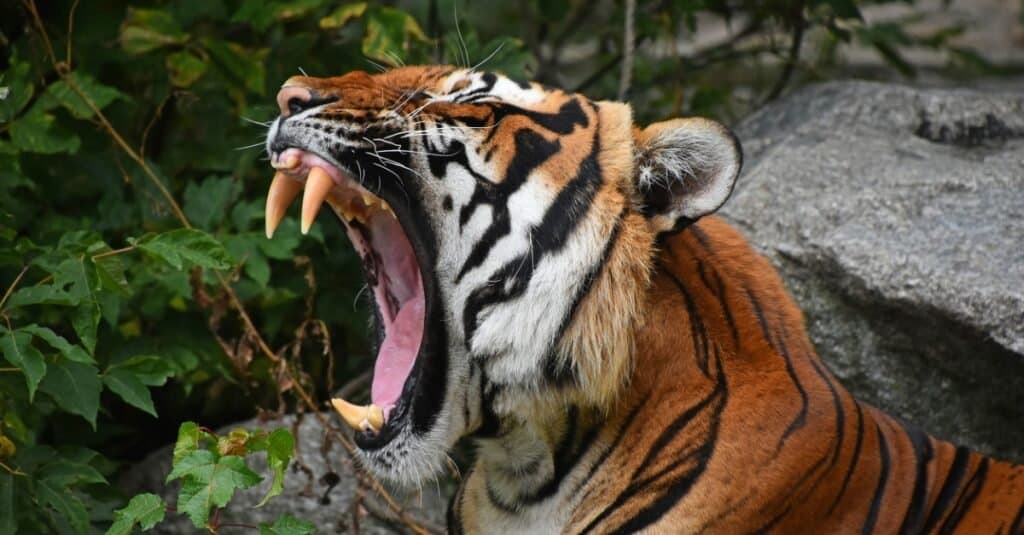
A tiger’s canine teeth can be up to 4 inches long.
©iStock.com/BreakingTheWalls
Bite force is the amount of pressure an animal’s jaws exert on an object, such as prey. Essentially, it measures the combined force produced by the animal’s muscles and upper and lower jaws. It is measured in pounds per square inch (psi). This means it measures the pressure of a one-pound force on an area of one square inch. Bite force measurements take the animal’s size into consideration and compute accordingly, so this measurement can be used to compare different species.
Several factors affect bite force. The size and shape of the skull, jawbone, tooth surfaces, and jaw muscles all play into how much pressure an animal can exert with its mouth. The size of prey an animal is biting can also affect the force they are able to produce.
Bite force is important for predators, as it allows them to grab and securely hold their prey. A strong bite force also allows predators to kill their prey instantly with one bite, reducing the risk of the prey animal escaping. Research has shown that animals that take larger prey generally have higher bite forces.
The Tiger’s Bite
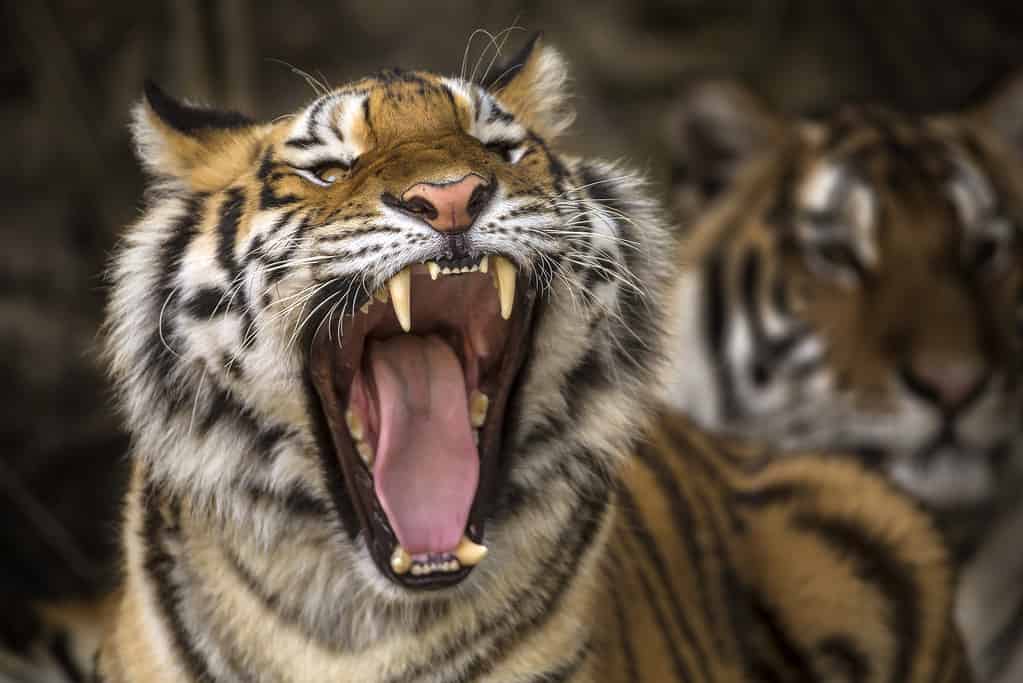
Tigers have 30 teeth, with 16 teeth in their upper jaw and 14 in the lower jaw.
©next143/iStock via Getty Images
There are several species of tiger, with Amur tigers (also known as Siberian tigers) generally believed to top the charts in size.
Male Amurs can weigh over 650 pounds and measure up to 12 feet long including their tail. While Bengal tigers aren’t litter either, they are smaller than their Siberian counterparts, weighing 200-600 pounds and measuring 6-10 feet long. The largest wild tiger ever recorded was a Bengal, measuring 10 feet, 7 inches long and weighing 857 pounds. While the largest captive tiger was a Siberian that weighed nearly 1,000 pounds, Siberian tigers in the wild seem to be decreasing in size due to the poaching of larger animals and a reduction in large prey populations.
But remember, size isn’t everything when it comes to bite. When everything is taken into consideration, Bengal tigers actually have a higher bite force on average than Siberian tigers. The maximum bite force for a Bengal is recorded to be 1,050 psi, while Siberians max out at around 950 psi. Both are impressive: A human’s bite force is between 120-160 psi, making the bite force of the tiger over six times stronger than that of a human. This also puts tigers near the top of the list in bite force when compared to other big cats.
Tigers can carry twice their body weight into a tree and exert around 10,000 pounds of force with a swipe of their paw! These big cats are nothing to mess with.
Other Big Cats
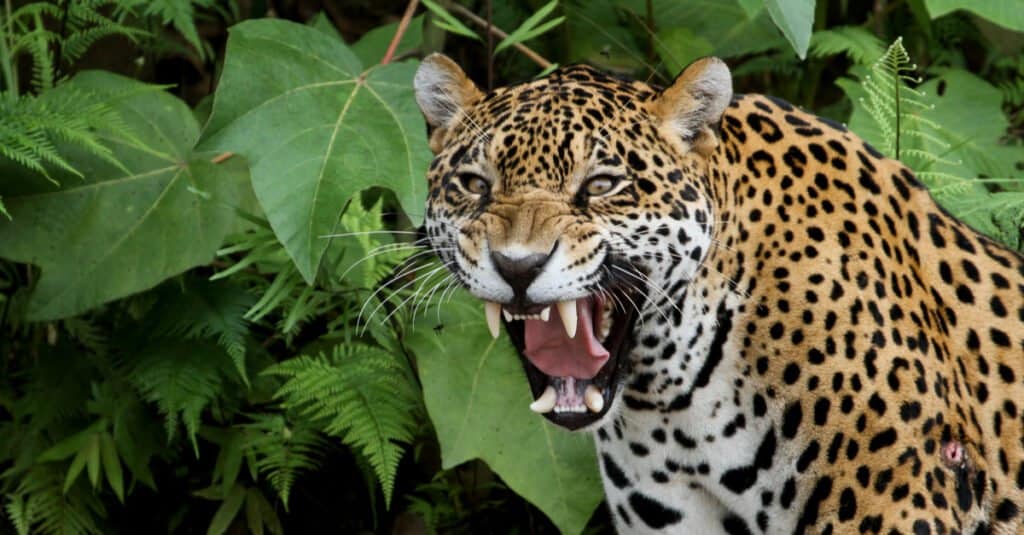
Jaguars can be found throughout South and Central America and up into the southern United States.
©Adalbert Dragon/Shutterstock.com
While the tiger is the largest of the big cats, one species outranks them in bite force. The secretive jaguar has a stronger bite force of 1,500 psi. Their strong, robust skull structure supports extremely strong jaws with jaw muscles that are stronger than those of other cats. The small bobcat also has an impressive jaw strength of 800 psi, proving that size isn’t everything. The African lion’s bite force is contested but generally agreed to be somewhere between 650 and 1,000 psi.
Even the African caracal, with a bite force of just 150-200 psi, puts the domestic house cat to shame. While it might feel like more when they bite you, your pet cat only has a bite force of around 70 psi.
Bite Force of Big Cat Species
| Animal | Bite Force in psi |
|---|---|
| Jaguar | 1,500 psi |
| Bengal Tiger | 1,050 psi |
| Siberian Tiger | 950 psi |
| Bobcat | 800 psi |
| Lion | 650-1,000 psi |
| Cheetah | 475 psi |
| Leopard | 450 psi |
| Mountain Lion | 400 psi |
| Caracal | 150-200 psi |
| Domestic House Cat | 70 psi |
Bite Force Compared to Other Animals

A saltwater
crocodile
can live 70-100 years.
©Danny Ye/Shutterstock.com
While the tiger is undeniably strong, they aren’t the strongest biters in the world. Many other species employ jaws designed for crushing prey. Check out where tigers rank compared to some of the world’s strongest jaws.
| Animal | Bite Force in psi |
|---|---|
| Orca Whale | 19,000 psi |
| Great White Shark | 4,000 psi |
| Saltwater Crocodile | 3,700 psi |
| Nile Crocodile | 3,000 psi |
| American Alligator | 2,980 psi |
| Hippopotamus | 1,800 psi |
| Gorilla | 1,300 psi |
| Bengal Tiger | 1,050 psi |
| Hyena | 1,000 psi |
The photo featured at the top of this post is © Thorsten Spoerlein/Shutterstock.com
Thank you for reading! Have some feedback for us? Contact the AZ Animals editorial team.



